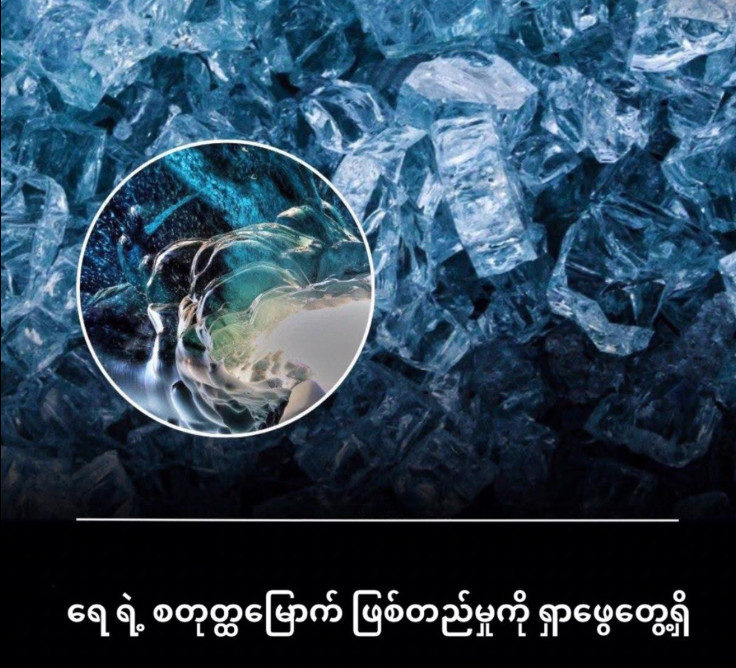Neptune ဂြိုဟ်ပေါ်ရှိ လေတိုက်နှုန်းဟာ တစ်နာရီကို မိုင် 1200 နှုန်း ရှိပြီး နေအဖွဲအစည်းထဲမှာ
လေတိုက်နှုန်း အပြင်းထန်ဆုံး ဂြိုဟ်တစ်လုံးဖြစ်ပါတယ်
#knowledge #ဗဟုသုတ

Discover postsExplore captivating content and diverse perspectives on our Discover page. Uncover fresh ideas and engage in meaningful conversations
Neptune ဂြိုဟ်ပေါ်ရှိ လေတိုက်နှုန်းဟာ တစ်နာရီကို မိုင် 1200 နှုန်း ရှိပြီး နေအဖွဲအစည်းထဲမှာ
လေတိုက်နှုန်း အပြင်းထန်ဆုံး ဂြိုဟ်တစ်လုံးဖြစ်ပါတယ်
#knowledge #ဗဟုသုတ

မရှိတာတွေအပေါ် အာရုံစိုက်နေသရွေ့ ဘယ်တော့မှ လုံလောက်ပြီလို့ ခံစားရမှာ မဟုတ်ဘူးတဲ့ ။ အများကြီး ရှိနေတာတောင်မှ စိတ်ထဲမှာ Empty Feeling ကလိုင်ပေါက် ဖြစ်နေတဲ့သူတွေ ရှိပါတယ် ။ တချို့ကျတော့လည်း ရလာတဲ့ အသေးအဖွဲလေးကအစ ကျေးဇူးတင် ဝမ်းမြောက်တတ်တဲ့အခါ သူ့မှာ လုံလောက်နေပြီ ပြည့်စုံကြွယ်ဝနေပြီလို့ ခံစားနေရတတ်ပါတယ် ။
ဘဝထဲမှာ လက်ခံရရှိပြီးသား အရာတွေအပေါ် ဘယ်လိုအမြင်မျိုး ရှိပါသလဲ ။ လုံလောက်တယ်လို့ ခံစားရပါသလား ။ ထပ်ဝယ်ရဦးမယ် ။ ထပ်လိုချင်သေးတယ် ။ ထပ်ဖြည့်ဆည်းရဦးမယ်လို့ ဖြစ်နေပါသေးလား ။ ထပ်ဝယ်ဖြည့်လိုက်တဲ့အခါမှာ ဘယ်လိုခံစားရပါသလဲ ။ ပြည့်စုံသွားပြီလို့ ခံစားရပါသလား ။
ခံစားရတယ်ဆိုရင် အဲဒီခံစားမှုဟာ ခဏတာ ခံစားရတဲ့ ရောင့်ရဲတင်းတိမ်မှုလား ။ ဘဝမှာ တကယ်ကို နှစ်နှစ်ကာကာ ပျော်ရွှင်ချင်တယ်...။ ပြည့်စုံ ချမ်းသာချင်တယ် ။ ငြိမ်းအေးချင်တယ်ဆိုတဲ့ Abundance Mentality ကို ရချင်တယ်ဆိုရင် Lack Mentality ကို ပြောင်းလဲယူရမှာ ဖြစ်ပါတယ် ။
#မွန်ဟော်စီ

Every lesson will repeat until you learn it တဲ့
ဖတ်ခဲ့ဖူးတဲ့ စာလေးတစ်ကြောင်းပေါ့ ။ လူတွေက ဘယ်အချိန်မှာ တစ်ဆင့်ပိုပြီး ရင့်ကျက်ပြီလဲ ၊ ပိုပြီး တိုးတက်လာမလဲ ၊ ပြောင်းလဲသွားမလဲဆိုရင် သူတို့ ကြုံတွေ့ရတဲ့ကိစ္စရပ်ကနေ သင်ခန်းစာယူနိုင်တဲ့အချိန်မှ ကျွန်တော်တို့ဟာ ဘဝမှာ အပြောင်းအလဲတွေ ဖြစ်မှာပါ ။
ဒီလို ကိုယ့်ဘဝမှာ ကြုံဖူးတဲ့ ပြဿနာတွေ ၊ အခက်အခဲတွေ ၊ ဒုက္ခတွေကို သင်ခန်းစာမယူဘဲ ဒီတိုင်းနေနေရင်
မရှောင်လွှဲရင်တော့ ဘာမှလည်း တိုးတက်ပြောင်းလဲမှာမဟုတ်ဘဲ ဒီ traumaတွေထဲပဲ တဝဲလည်လည် ဖြစ်နေမှာပါ
ဘယ်လိုအရာတွေလဲဆို ကျွန်တော်တို့ လုပ်ခဲ့ဖူးတဲ့ အမှားတွေ ၊ မလိုအပ်တဲ့နေရာမှာ ငွေကြေးသုံးစွဲနေတာတွေ ၊ Toxic Relationshipတွေ ၊ Negative mindset တွေ ၊ self- discipline မရှိတာတွေ ၊ အမှတ်မရှိတာတွေ စသဖြင့်ပေါ့ ။
ဘဝမှာ ဘာပဲကြုံလာရကြုံလာရ ဒီအဖြစ်အပျက်ကြောင့်တစ်ခါခံရပြီးရင် သင်ခန်းစာယူပြီး ပြောင်းလဲပစ်နိုင်မှ တိုးတက်ပြောင်းလဲမှာပါ။အဲ့လိုမဟုတ်ဘဲ ဒုံရင်းပဲဆိုရင်တော့ ဒုံရင်းအတိုင်း ပြဿနာတွေနဲ့အရင်လိုပဲ ချာလည်လည်နေမှာပါ။
မလိုအပ်တဲ့ နေရာတွေမှာ ငွေသုံးနေတာတွေ မလျော့ချပြီး လက်ထဲငွေပြတ်မှ နောင်တရမယ် ၊ ငွေပြတ်တုန်း ခဏပဲနောင်တရလိုက်တယ် ။ ငွေထပ်ရလာရင် ဒုံရင်းပဲ ဖြစ်သွားတယ် ။ ပြန်ပြီး သုံးဖြုန်းနေတယ် ။ ဒီလိုနဲ့ ငွေပြန်ပျက်တယ် ။ အဲ့ကျမှ နောင်တပြန်ရတယ် ။ ဒီအတိုင်းပဲ လည်နေတယ် ဘဝမှာ မစုဆောင်းမိဘူး ။ Toxic Relationship တွေကြုံရတယ် ။ ဘဝထဲကို လူတွေကို အကဲမခတ်ဘဲ လွယ်လွယ်ဝင်ခွင့်ပေးတယ် ။ လူကောင်းလား လူဆိုးလားဆိုတာထက် စိတ်ခံစားချက်ကိုပဲ ဦးစားပေးတယ် ။
ကိုယ့်အပေါ် မလေးမစားလုပ်တာ ဦးစားမပေးတာ ၊ အလေးမထားတာတွေလည်း လက်ခံတယ် ၊ ဇာတ်မျောကြီးတွေကို မရပ်တန့်နိုင်ဘူး ။ နောက်တစ်ယောက်ကျလည်း ဒီလိုပဲ ကိုယ့်တန်ဖိုးကို မသတ်မှတ်ထားဘူး ။ ဘဝမှာ ကောင်းတဲ့လူနဲ့ မဆုံတွေ့နိုင်တော့ဘူး ။ ဘာလို့ဆိုကိုယ်တိုင်က ကိုယ့်တန်ဖိုးကို ချပေးနေတာ ငါ့ကို ဖြစ်သလိုဆက်ဆံလို့ရတယ် ။ ငါ့ကို ပေးတဲ့ကတိတွေ မတည်လည်း ရတယ် ။ လုပ်ချင်သလိုလုပ်ပြီး ပြန်လာခေါ်လည်း လက်ခံတယ် ။ Priority မထားလည်း ရတယ် ။
သင်ခန်းစာမယူဘူး အဲ့တော့ healthy relationships ကဘာလဲဆိုတာကိုမသိဘူး ။ ပြုလည်းမပြုပြင်ဘူး ။ ဒီcycleထဲမှာပဲ လည်နေတယ် ။
တစ်နှစ်ကုန်သွားတယ် ။ ဘာမှမကြိုးစားမိဘူး ။ နောက်တစ်နှစ်မှ ထပ်ကြိုးစားမယ် ကျိန်းဝါးပြန်တယ် ။ နောက်တစ်နှစ်ရောက်တော့လည်း ဒီတိုင်းပဲ ။ သင်ခန်းစာယူသလိုလိုနဲ့ မယူဘူး ။
ဘဝမှာ ဒီလို အဖြစ်အပျက်တွေ အများကြီး ကျွန်တော်တို့ဆီမှာ ဖြစ်နေပါတယ် ။ ကျွန်တော်တို့က ငါတော့ တော်ပြီ ဒါမျိုး ငါ့ဘဝမှာ ထပ်အဖြစ်မခံတော့ဘူးလို့ မဆုံးဖြတ်မချင်း သင်ခန်းစာယူပြီး မပြုပြင်မချင်း ဒီ စက်ဝိုင်းကလည်ပတ်နေဦးမှာပါ။
#အချိန်မီစတင်ခြင်း-စာအုပ်မှ
#nayvel
ဒါကြောင့် ဘဝပြောင်းလဲဖို့ဆိုရင် သင်ခန်းစာယူပါ

ဒီစာအုပ်က ဘဝမှာ အနာဂတ်ပျောက်ဆုံးနေတဲ့ လူငယ်တွေ ၊ စိတ်ဓာတ်ကျနေတဲ့ လူငယ်တွေအတွက် ရည်ရွယ်ပြီး ရေးထားတဲ့ Self-help အမျိုးအစားထဲက စာအုပ်လေးတစ်အုပ် ဖြစ်ပါတယ် ။
ဒီစာအုပ်က အပျင်းပြေခဏတဖြုတ် ဖတ်ဖို့စာအုပ် မဟုတ်သလို ၊ ဖတ်ပြီးသွားတဲ့အခါ မေ့ပစ်ထားရမယ့် စာအုပ်လည်းမဟုတ်ဘူး ။ ဒီစာအုပ် ဖတ်ပြီးတဲ့အခါ ကိုယ့်ကိုယ်ကိုယ် မေးတတ်လာလိမ့်မယ် ။ " နေ့တိုင်း ငါ ဘာတွေလုပ်နေသလဲ ။ ပြီးတော့ ငါ ဘာတွေပြောင်းလဲဖို့ လိုပြီလဲ ။ " ဒီလို ကိုယ့်ကိုယ်ကို မေးတတ်လာတဲ့အခါ ကိုယ့်မှာ ပညာရေးအားနည်းနေရင် စိတ်ပူစရာမလိုဘူး ။ Self-educated ဖြစ်လာဖို့ ဒီစာအုပ်က လမ်းညွှန်ပေးလိမ့်မယ် ။ ဘာကြောင့်လဲဆိုတော့ ဘဝဆိုတာ မကုန်ခန်းနိုင်တဲ့ သင်ခန်းစာတွေ နေ့စဥ် ပေးနေတာဖြစ်တဲ့အတွက် ကိုယ့်ကိုယ်ကို ပညာတတ်တစ်ယောက်ဖြစ်လာအောင် ပြုစုပျိုးထောင်ဖို့ လိုအပ်တယ်
ဆင်းဆင်းရဲရဲ မွေးလာခဲ့တာ ကိုယ့်အပြစ် မဟုတ်ပေမယ့် တစ်သက်လုံး ဆင်းဆင်းရဲရဲ နေသွားတယ်ဆိုရင်တော့ ဒါဟာ ကိုယ့်အပြစ်ပါပဲ ။ ဒါကြောင့် အနာဂတ်မှာ ပိုကောင်းမွန်တဲ့ ဘဝတစ်ခု ဖြစ်လာအောင် ဘယ်လိုစီးပွားရေးတွေမှာ ပိုပြီးရင်းနှီးမြှုပ်နှံသင့်သလဲ ။ ငွေကို ဘယ်လိုစီမံခန့်ခွဲသင့်သလဲ ။ ငွေကြေးပြည့်စုံခြင်းဟာ လူရာဝင်ခြင်းတစ်မျိုးပဲ ။ ဒါကြောင့် ငွေရှိဖို့လိုတယ် ။
ဘဝပျော်ရွှင်မှုဆိုတာ ငွေကြေးတစ်ခုတည်းအပေါ်မှာ မှီတည်နေတာ မဟုတ်ဘူး ။ ကျန်းမာရေးကောင်းမွန်မှုနဲ့ စိတ်ပိုင်းဆိုင်ရာ တည်ငြိမ်အေးချမ်းမှုရှိနေမှ စစ်မှန်တဲ့ ပျော်ရွှင်မှုက တကယ်ရမှာ ။ စစ်မှန်တဲ့ ပျော်ရွှင်မှုက Inner world မှာပဲ အမှန်တကယ် ရှိနေတာ ။
21 ရာစုက လူတွေဟာ ရုပ်ဝတ္တုပိုင်းဆိုင်ရာ ဖွံ့ဖြိုးတိုးတက်လာတာနှင့်အမျှ စိတ်ပိုင်းဆိုင်ရာ ချို့တဲ့လာတယ် ။ ထိလွယ်ရှလွယ် ဖြစ်လာတယ် ။ ခံနိုင်ရည်တွေ လျော့ပါးလာတယ် ။
ဒါကြောင့် စိတ်ရဲ့ အေးချမ်းတည်ငြိမ်မှုကို ရှာဖို့လိုအပ်တယ် ။ တကယ်တော့ ငြိမ်းချမ်းတဲ့စိတ်က အတွင်းအဇ္စျတ္တမှာပဲ ရှိပါတယ် ။ ဒီတော့ ကျွန်တော်တို့တွေ ကြည့်နေကျ ၊ မြင်နေကျ မှန်ပြောင်းထဲကနေ မြင်နေရတဲ့ လောကကြီးထဲက ခဏတဖြုတ်ရုန်းထွက်ပြီး ကိုယ်မမြင်နိုင်သေးတဲ့ ဖြစ်တည်မှု သဘာဝတရားကို တွေ့အောင်ရှာကြည့်ဖို့ အကြံပြုထားတဲ့ စာအုပ်ကောင်းလေးတစ်အုပ်ပဲ ဖြစ်ပါတယ် ။
ပညာရေး ၊ စီးပွားရေး ၊ ကျန်းမာရေးအတွက်တင် မဟုတ်ဘဲ စစ်မှန်တဲ့ဘဝရဲ့ ပျော်ရွှင်မှု ၊ ငြိမ်းအေးမှု ၊ ဘဝရဲ့အဓိပ္ပါယ်ဆိုတာ လူအများ Definition ဖွင့်သလိုမဟုတ်ဘဲ ဒီစာအုပ်က တိတိကျကျ လမ်းညွှန်ပေးထားတဲ့ စာပေဟင်းလေးအိုးကြီး ။ " ငါ့ကိုယ်ငါ ပြောင်းလဲခြင်း " စာအုပ်လေးဟာ ဖတ်ရတာ တန်လိုက်တာလို့ ခံစားရစေမှာပဲ ဖြစ်ပါတယ် ။
ကိုယ့်ကမ္ဘာငယ်လေးကိုပဲ လှပအောင် မိမိကိုယ်တိုင် ဖန်တီးပြုပြင်လိုက်မယ်ဆိုရင် တခြားကမ္ဘာငယ်လေးတွေအားလုံးလည်း ကိုယ်စီ လှပလာပါလိမ့်မယ် ။ ဒီတော့
" ငါ့ကိုယ်ငါ ပြောင်းလဲဖို့ပဲ " လိုပါတယ်။
#အံ့ဘုန်းခန့်ကျော်
#ငါ့ကိုယ်ငါပြောင်းလဲခြင်း

T_i-n_k-e_r B_e-l_l A_n-d T_h-e P_i-r_a-t_e F_a-i_r-y (2014)
IMDb Rating – 7.1/10
အညွှန်း* 🔽🔽🔽
အတောင်ပံတစ်စုံနဲ့နတ်သမီးလေးတွေအများစုနေတဲ့နေရာလေးတစ်ခုသူတိုဗိမ္မန် မှာ ဘုရင်မတစ်ပါးအုပ်ချုပ်တယ်။ ကာကွယ်ရေးအဖွဲတစ်ခုရှိသလို ကန့်သတ်စည်းမျဉ်းစည်းကမ်းမြောက်များစွာလည်းရှိတယ်။အထူးသဖြင့်နတ်သူငယ်တွေကိုရန်ပြုမဲ့တိရစ္ဆာန်တွေကိုကြိုတင်ကာကွယ်ခြင်းအနေနဲ့ သူတိုနေတဲ့အနားကိုအကပ်တောင်မခံတာပါပဲ။ ဒါကလည်း ရှေးရိုးအစဉ်အဆက်လက်ဆင့်ကမ်းရေးသားခဲ့တဲ့ မူတွေအကြောင်းအရာတွေကြောင့် လုပ်နေရတာပါပဲ။ ဒီထဲမှာတမူကွဲထွက်လာတာကFAWNလိုခေါ်တဲ့နတ်သမီးလေးတစ်ပါးပါပဲ။ ရက်စက်တယ်လိုသတ်မှတ်ထားတဲ့အကောင် ကြီးတွေမှာလည်း သူတိုလိုနှလုံးသားရှိလေတော့ သိမ်မွေ့နူးညံခြင်းတွေရှိမှာပဲလိုသူခံစားနေရတယ်။
#credit
ဇာတ်ကားကြည့်ရန် 🔽🔽🔽
https://t.me/Bhone2312/305
https://t.me/Bhone2312/305

ထူးဆန်းတဲ့ကောင်မလေး နှင့် သားရဲကောင်ကြီးရဲ့ အချစ်ဇာတ်လမ်း
B_e-a_u-t_y a_n-d t_h-e B_e-a_s-t (1991)
အညွှန်း* 🔽🔽🔽
ဇာတ်ကားလေးမှာတော့ မြတ်နိုးတန်ဖိုးထားခံရတဲ့ ဘဲလ်ဆိုတဲ့ဇာတ်ကောင်နဲ့ သွင်ပြင်ဆိုးဆိုး သားရဲကောင်ကြီးတိုကြားက(သေချာလေး ကြည့်ကြည့်မိရင် သတိထားမိရင်) အဓိပ္ပါယ်တွေများစွာရှိတဲ့အချစ်ဇာတ်လမ်းလေးတစ်ပုဒ်ပေါ့။ စာဂျပိုးလေးလို ပြောလိုရတဲ့ဘဲလ်ဟာ သူ့မြိုငယ်လေးမှာတော့ လူတောမတိုးတဲ့မိန်းကလေးတစ်ယောက်လို၊ ထူးဆန်းပြီးကြောင်တောင်တောင်လို ထင်မြင်ခံရတဲ့မိန်းကလေးတစ်ယောက်လိုသတ်မှတ်ခံရတဲ့ မိန်းကလေးတစ်ယောက်ပေါ့။နိစ္စဓူဝငြီးငွေ့စရာ (အဲ့ဒီအချိန်တွေတုန်းက) သတ်မှတ်ထားတဲ့စံဆိုတာတွေနဲ့ မကိုက်လို လူဝင်မဆန့်သလိုဖြစ်နေတဲ့မိန်းမလှလေး ဘဲလ်နဲ့ လူတွေအဝေးမှာ သီးခြားပုန်းအောင်းရှင်သန်နေတဲ့ကျိန်စာသင့် သားရဲကောင်မင်းသားလေးတိုရဲ့ ဇာတ်လမ်းလေးပါ....
#credit
ဇာတ်ကားကြည့်ရန် 🔽🔽🔽
https://t.me/Bhone2312/307
https://t.me/Bhone2312/307

M_i-g_r-a_t-i_o-n (2023)
အညွှန်း* 🔽🔽🔽
ဒီဘဲမိသားစုလေးဟာဆိုရင် အမေရိကန်မူးစ်ဟတ်ရေအိုင်လေးမှာပဲအမြဲအတည်တကျနေထိုင်ခဲ့ကြတာ သူတိုတစ်သက်တာပါပဲ...။ဘာလိုလည်းဆိုတော့ ရေအိုင်ရဲ့အပြင်မှာဆိုရင် ဘေးဒုက္ခတွေအပြည့်၊သားရဲတွေအပြည့်ဆိုတာကို ကာကွယ်တတ်လွန်းတဲ့ဘဲဖေဖေကြီးကပုံပြင်တွေပြောပြရင်းအမြဲခြောက်လှန့်ထားလိုပါ။သိုပေမဲ့ စူးစမ်းချင်တဲ့ ဘဲပေါက်လေးနှစ်ကောင်က ငယ်ရွယ်သူတိုသဘာဝအတိုင်း အပြင်လောကကိုစူးစမ်းချင်ကြောင်း ပူဆာတယ်...။ဘဲမေမေကြီးကလည်း အခြားဘဲခေါင်းစိမ်းတွေ အသိုက်ပြောင်းတာ၊လောကကြီးထဲခြေဆန့်တာမြင်တော့ စွန့်စားခန်းတွေအားကျမိပြန်ပါတယ်။
#credit
ဇာတ်ကားကြည့်ရန် 🔽🔽🔽
https://t.me/Bhone2312/309
https://t.me/Bhone2312/309

TON 618 ဆိုတာ လူသားတွေ ရှာဖွေတွေ့ရှိထားသမျှ မရေတွက်နိုင်တဲ့ အနန္တ စကြဝဠာ (Observable Universe) ထဲ အကြီးဆုံးတွင်းနက်ကြီးပါ။
ကမ္ဘာကနေ အလင်းနှစ် ၁၀.၄ ဘီလီယံ အကွာအဝေးမှာ ရှိနေတာဖြစ်ပြီး သူ့ ဒြပ်ထုကို အနီးစပ်ဆုံးပြောရရင် နေ အလုံးပေါင်း ၆၆ ဘီလီယံ စာလောက် ရှိပါတယ်။ နေအဖွဲ့အစည်းလို အစုအဝေးပေါင်း ထောင်သောင်းချီကို တခဏအတွင်း စုပ်ယူပစ်နိုင်ပါတယ်။
ဒီပုံကတော့ ကိုယ်တွေနေတဲ့ ကမ္ဘာမြေကြီးရှိရာ နေအဖွဲ့အစည်းကို TON 618 ဆိုတဲ့ တွင်းနက်ကြီးနဲ့ နှိုင်းယှဉ်ပြထားတာပဲ ဖြစ်ပါတယ်။
အလယ်က မြားပြထားတဲ့ အစက်လေး တစက် ကတော့ နေ၊ ကမ္ဘာ၊ ဗီးနပ်စ်၊ ဂျူပီတာ၊ မားစ်၊ မာကျူရီ ၊ စေတန် ၊ ယူရေးနပ်စ်၊ နပ္ပကျွန်း ဂြိုဟ်တွေပေါ့။
တကယ်တော့ စကြာဝဠာထဲမှာ လူသားဆိုတာ တည်ရှိနေမှန်းသတိထားဖို့တောင် ခက်လွန်းတဲ့ အမှုန်အမွှားဆိုတာထက်ကို သေးငယ်လွန်းလှပါတယ်။

လူသားတွေဟာ ရေ ကို အခဲ ၊ အရည် ၊ ရေငွေ့ ဆိုတဲ့ ပုံစံ (၃) မျိုးနဲ့ပဲ တည်ရှိနိုင်တယ် ဆိုပြီး သိထားတာ ဖြစ်ပါတယ်။ ဒါပေမဲ့ ဒီအယူအဆကို ပိုပြီး တိုးတက်လာစေတဲ့ တွေ့ရှိမှုကို နပ္ပကျွန်း နဲ့ ယူရေးနပ်စ် တို့မှာ ရှာဖွေနိုင်ခဲ့ပါပြီ။ အဲ့ဒီ စတုတ္ထမြောက် တည်ရှိမှုပုံစံကို “ဆူပါအိုင်ယွန်းနစ်ခဲရည်” လို့ အမည်ပေးထားပါတယ်။
ရေဟာ လွန်ကဲတဲ့ အပူချိန်နဲ့ ဖိအားအောက်ရောက်ရင် အခဲ အခြေအနေမှာရော အရည် အခြေအနေမှာပါ တပြိုင်နက် တည်နေတဲ့ ပုံစံပါ။ ဒီနေရာမှာ “တပြိုင်နက်” ဆိုတဲ့စကားလုံးက သိပ်အရေးကြီးပါတယ်။ ရေက အငွေ့ပျံနေဆဲ အခြေအနေမျိုး၊ ရေကနေ ရေခဲဖြစ်နေဆဲ အခြေအနေမျိုး၊ ရေခဲ အရည်ပျော်နေဆဲ အခြေအနေမျိုးကို ဆိုလိုတာ မဟုတ်ပါဘူး။ ဆူပါအိုင်ယွန်းနစ်ခဲရည် ဆိုတာ Liquid Hydrogen နဲ့ Crystallised Oxygen အတူတကွ တည်ရှိနေတာမျိုးပါ။
Hydrogen နဲ့ Oxygen ပါတဲ့ H2O molecules ရဲ့
အောက်ဆီဂျင် အက်တမ်တွေဟာ ပုံဆောင်ခဲအဖြစ်ကို ရောက်သွားပြီး ဟိုက်ဒြိုဂျင် အက်တမ်တွေကတော့ အရည်သဘာဝကိုယူပြီး free-flow state ဖြစ်သွားပါတယ်။ ဒီ အခြေအနေမှာ ရေ ဟာ အနက်ရောင်ဖြစ်နေပြီး၊ သိပ်သည်းဆ အလွန်မြင့်ကာ တခြား သတ္တုတွေလိုပဲ လျှပ်စစ်စီးနိုင်ဦးမှာ ဖြစ်ပါတယ်။
ဒီတွေ့ရှိမှုကနေ ရေခဲဖုံးလွှမ်းတဲ့ ဂြိုဟ်တွေရဲ့ ထူးဆန်းရှုပ်ထွေးတဲ့ လျှပ်စစ်သံလိုက်စက်ကွင်းတွေအကြောင်းကို ကနဦး လေ့လာနိုင်မှာဖြစ်ပြီး ၊ ရေနဲ့ ပတ်သက်လို့ လက်ခံထားတဲ့ ရူပဗေဒ သဘောတရားတွေကိုလည်း ပြန်လည်သုံးသပ်ရတော့မှာ ဖြစ်ပါတယ်။
ရေဟာ အဲ့ဒီလို အင်မတန် ပူပြင်းပြီး ဖိအားများပြားတဲ့ ပတ်ဝန်းကျင် အခြေအနေမှာ ဒီပုံစံနဲ့ တည်ရှိနေနိုင်သေးတယ်ဆိုရင် တခြား မထင်မှတ်ထားတဲ့ အခြေအနေမှာရော ဘယ်လိုပုံစံနဲ့ ရှိနေနိုင်ဦးမလဲ။ လူသားတွေ သိထားသမျှ သိပ္ပံပညာ၊ ရူပဗေဒ သဘောတရားနဲ့ တခြားတွေ့ရှိချက်တွေဟာ အလွန်ကျယ်ပြောတဲ့ စကြဝဠာကြီးထဲက ထူးခြားဆန်းကြယ်မှုတွေရဲ့ ဘယ်နှရာခိုင်နှုန်းလောက်ပဲ ရှိနေသေးတာလဲ။ လူတွေနေတဲ့ နေအဖွဲ့အစည်းမှာတင် စူးစမ်းလေ့လာစရာ မကုန်နိုင်အောင်ကို များပြားလွန်းလျက် ရှိနေပါသေးတယ်။
